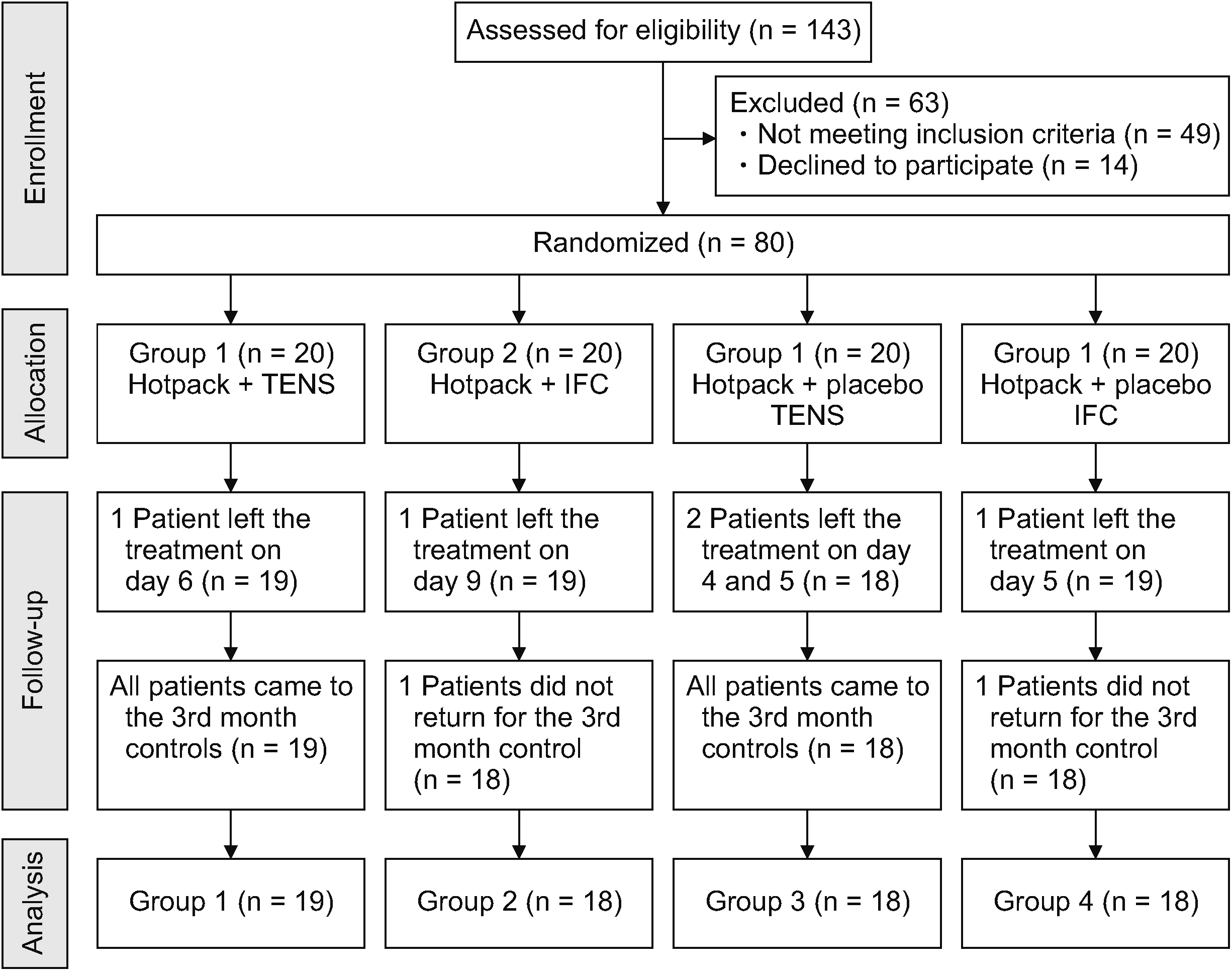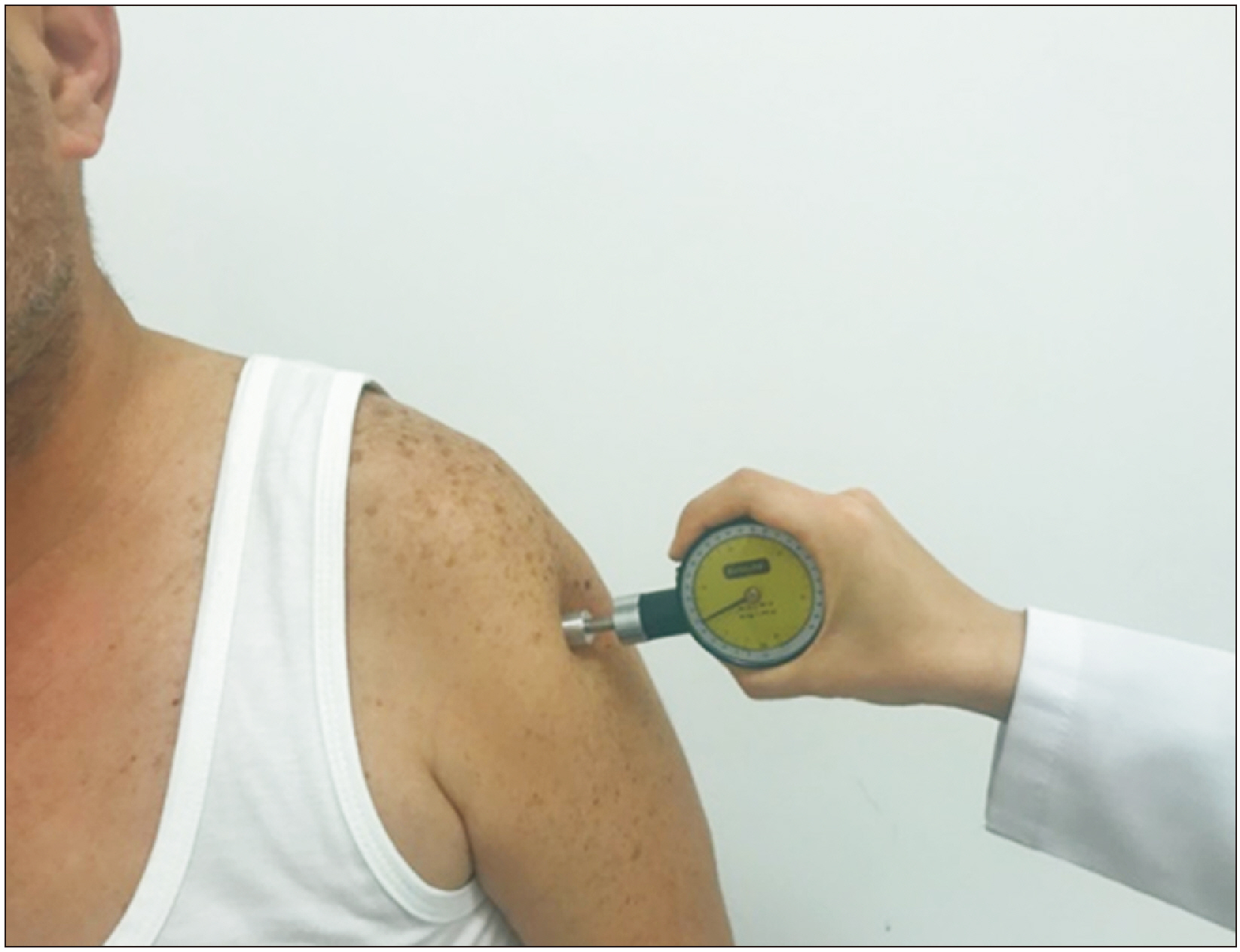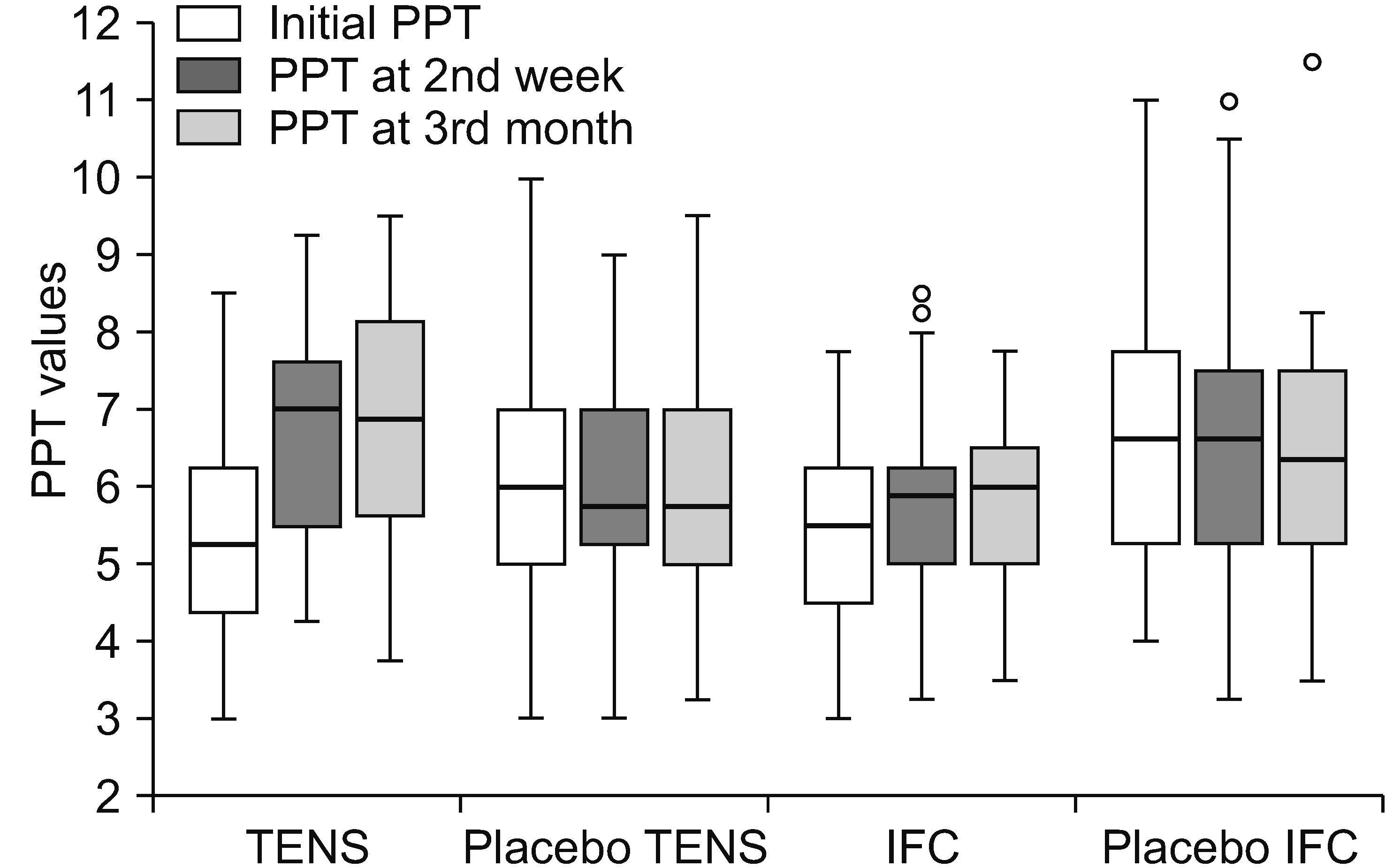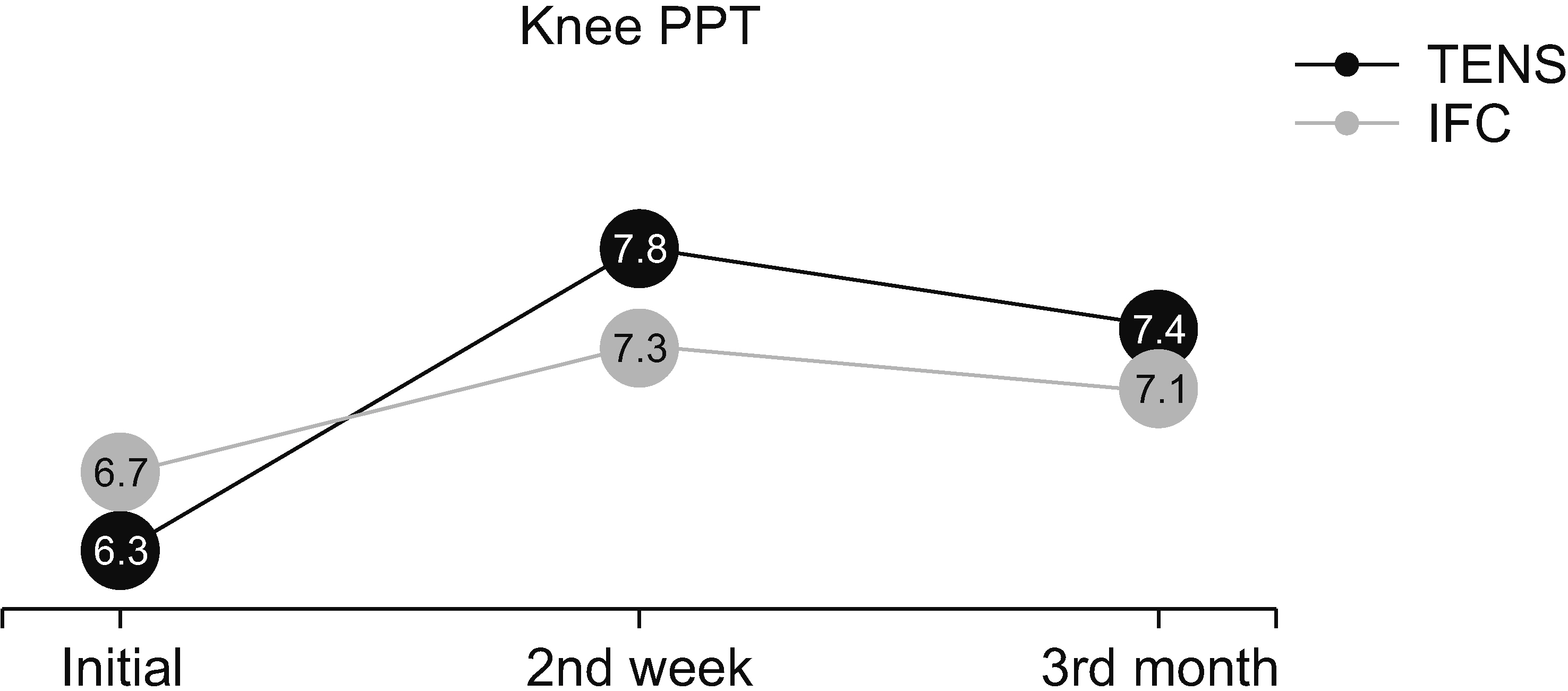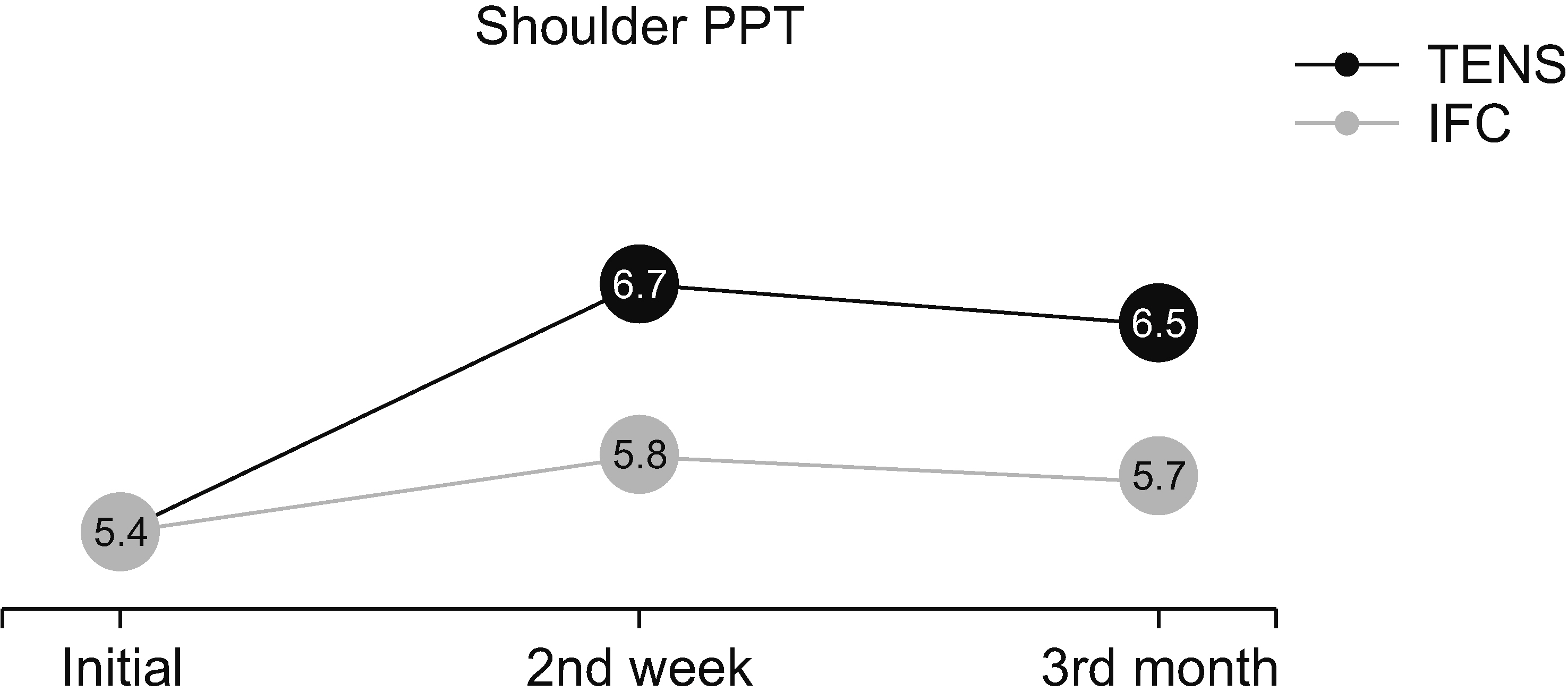Korean J Pain.
2023 Jul;36(3):392-403. 10.3344/kjp.23118.
Comparison of the effects of transcutaneous electrical nerve stimulation and interferential current therapies in central sensitization in patients with knee osteoarthritis
- Affiliations
-
- 1Department of Physical Medicine and Rehabilitation, University of Health Sciences Ankara Gaziler Physical Medicine and Rehabilitation Education and Research Hospital, Ankara, Türkiye
- 2Department of Physical Medicine and Rehabilitation, İzmir Bozyaka Education and Research Hospital, İzmir, Türkiye
- 3Department of Physical Medicine and Rehabilitation, Ankara City Hospital, Ankara, Türkiye
- KMID: 2544250
- DOI: http://doi.org/10.3344/kjp.23118
Abstract
- Background
This study is primarily aimed to determine whether transcutaneous electrical nerve stimulation (TENS) and interferential current (IFC) treatments have any effect on central sensitization (CS) in patients with knee osteoarthritis (OA) and to investigate which treatment is more effective.
Methods
In this randomized controlled trial, 80 patients were randomized into four treatment groups: TENS, Plasebo-TENS, IFC, and Plasebo-IFC. All interventions were applied 5 times a week for 2 weeks. Primary outcome was pressure pain threshold (PPT), which is accepted as the objective indicator of CS, at the painful knee and at the shoulder as a painless distant point. Other outcome measures were the visual analog scale (VAS), Western Ontario and McMaster Universities Osteoarthritis Index, Timed Up and Go Test, pain catastrophizing scale, Beck Depression Inventory, and Tampa Scale of Kinesiophobia.
Results
All assessment parameters were improved, without a significant difference among the groups except PPT. PPT scores were significantly improved in TENS and IFC groups when compared with the sham groups at 2 weeks and 3 months. In addition, this improvement was even more pronounced in the TENS group. Multivariable logistic regression analysis showed that the patient’s inclusion in the TENS group, an initial high PPT, and an initial low VAS score were independent risk factors for improvement in the PPT.
Conclusions
This study shows that TENS and IFC reduced pain sensitivity as compared to placebo groups in patients with knee OA. This effect was more pronounced in the TENS group.
Keyword
Figure
Reference
-
1. Lohmander LS, Roos EM. 2007; Clinical update: treating osteoarthritis. Lancet. 370:2082–4. DOI: 10.1016/S0140-6736(07)61879-0. PMID: 18156017.
Article2. Perrot S. 2015; Osteoarthritis pain. Best Pract Res Clin Rheumatol. 29:90–7. DOI: 10.1016/j.berh.2015.04.017. PMID: 26267003.
Article3. Fingleton C, Smart K, Moloney N, Fullen BM, Doody C. 2015; Pain sensitization in people with knee osteoarthritis: a systematic review and meta-analysis. Osteoarthritis Cartilage. 23:1043–56. DOI: 10.1016/j.joca.2015.02.163. PMID: 25749012.
Article4. Bannuru RR, Osani MC, Vaysbrot EE, Arden NK, Bennell K, Bierma-Zeinstra SMA, et al. 2019; OARSI guidelines for the non-surgical management of knee, hip, and polyarticular osteoarthritis. Osteoarthritis Cartilage. 27:1578–89. DOI: 10.1016/j.joca.2019.06.011. PMID: 31278997.
Article5. Lluch E, Nijs J, Courtney CA, Rebbeck T, Wylde V, Baert I, et al. 2018; Clinical descriptors for the recognition of central sensitization pain in patients with knee osteoarthritis. Disabil Rehabil. 40:2836–45. DOI: 10.1080/09638288.2017.1358770. PMID: 28768437.
Article6. Moore RL, Clifford AM, Moloney N, Doody C, Smart KM, O'Leary H. 2020; The relationship between clinical and quantitative measures of pain sensitization in knee osteoarthritis. Clin J Pain. 36:336–43. DOI: 10.1097/AJP.0000000000000798. PMID: 31977373.
Article7. Arendt-Nielsen L, Skou ST, Nielsen TA, Petersen KK. 2015; Altered central sensitization and pain modulation in the CNS in chronic joint pain. Curr Osteoporos Rep. 13:225–34. DOI: 10.1007/s11914-015-0276-x. PMID: 26026770.
Article8. Akin-Akinyosoye K, Frowd N, Marshall L, Stocks J, Fernandes GS, Valdes A, et al. 2018; Traits associated with central pain augmentation in the Knee Pain In the Community (KPIC) cohort. Pain. 159:1035–44. DOI: 10.1097/j.pain.0000000000001183. PMID: 29438225. PMCID: PMC5959005.
Article9. Neblett R, Cohen H, Choi Y, Hartzell MM, Williams M, Mayer TG, et al. 2013; The Central Sensitization Inventory (CSI): establishing clinically significant values for identifying central sensitivity syndromes in an outpatient chronic pain sample. J Pain. 14:438–45. DOI: 10.1016/j.jpain.2012.11.012. PMID: 23490634. PMCID: PMC3644381.
Article10. Jeong Y, Leem JW, Chung SS, Kim YS, Yoon DM, Nam TS, et al. 2000; Mechanism of hyperalgesia following cutaneous inflammation by complete Freund adjuvant. Korean J Pain. 13:164–74.11. Cherian JJ, Jauregui JJ, Leichliter AK, Elmallah RK, Bhave A, Mont MA. 2016; The effects of various physical non-operative modalities on the pain in osteoarthritis of the knee. Bone Joint J. 98-B(1 Suppl A):89–94. DOI: 10.1302/0301-620X.98B1.36353. PMID: 26733650.
Article12. Tuncer T, Cay FH, Altan L, Gurer G, Kacar C, Ozcakir S, et al. 2018; 2017 update of the Turkish League Against Rheumatism (TLAR) evidence-based recommendations for the management of knee osteoarthritis. Rheumatol Int. 38:1315–31. DOI: 10.1007/s00296-018-4044-y. PMID: 29777340.
Article13. Hochberg MC, Altman RD, April KT, Benkhalti M, Guyatt G, McGowan J, et al. American College of Rheumatology. 2012; American College of Rheumatology 2012 recommendations for the use of nonpharmacologic and pharmacologic therapies in osteoarthritis of the hand, hip, and knee. Arthritis Care Res (Hoboken). 64:465–74. DOI: 10.1002/acr.21596. PMID: 22563589.
Article14. Vance CGT, Dailey DL, Chimenti RL, Van Gorp BJ, Crofford LJ, Sluka KA. 2022; Using TENS for pain control: update on the state of the evidence. Medicina (Kaunas). 58:1332. DOI: 10.3390/medicina58101332. PMID: 36295493. PMCID: PMC9611192. PMID: 88768f8548d9495083f8f6d4e830f7ab.
Article15. Rampazo ÉP, Liebano RE. 2022; Analgesic effects of interferential current therapy: a narrative review. Medicina (Kaunas). 58:141. DOI: 10.3390/medicina58010141. PMID: 35056448. PMCID: PMC8779694. PMID: 35c3ea2b58b94e989fe9dfe97bfb1e00.
Article16. Beckwée D, De Hertogh W, Lievens P, Bautmans I, Vaes P. 2012; Effect of tens on pain in relation to central sensitization in patients with osteoarthritis of the knee: study protocol of a randomized controlled trial. Trials. 13:21. DOI: 10.1186/1745-6215-13-21. PMID: 22353582. PMCID: PMC3307484. PMID: 0c2af86a924348e4894f77bcb9b05dd0.
Article17. Chen HL, Yang FA, Lee TH, Liou TH, Escorpizo R, Chen HC. 2022; Effectiveness of interferential current therapy in patients with knee osteoarthritis: a systematic review and meta-analysis of randomized controlled trials. Sci Rep. 12:9694. DOI: 10.1038/s41598-022-13478-6. PMID: 35690604. PMCID: PMC9188606. PMID: a679805595db467a9895d88fb902a2cb.
Article18. Atamaz FC, Durmaz B, Baydar M, Demircioglu OY, Iyiyapici A, Kuran B, et al. 2012; Comparison of the efficacy of transcutaneous electrical nerve stimulation, interferential currents, and shortwave diathermy in knee osteoarthritis: a double-blind, randomized, controlled, multicenter study. Arch Phys Med Rehabil. 93:748–56. DOI: 10.1016/j.apmr.2011.11.037. PMID: 22459699.
Article19. Kawasaki T, Inoue K, Ushiyama T, Fukuda S. 1998; Assessment of the American College of Rheumatology criteria for the classification and reporting of osteoarthritis of the knee. Ryumachi. 38:2–5. Japanese. PMID: 9564771.20. Kellgren JH, Lawrence JS. 1957; Radiological assessment of osteo-arthrosis. Ann Rheum Dis. 16:494–502. DOI: 10.1136/ard.16.4.494. PMID: 13498604. PMCID: PMC1006995.
Article21. Mehendale N, Inamdar M. 2020; A review on transcutaneous electrical nerve stimulation and its applications. SSRN [Priprint]. Available at: https://papers.ssrn.com/sol3/papers.cfm?abstract_id=3602962. cited 2022 Jun. DOI: 10.2139/ssrn.3602962.
Article22. Heller GZ, Manuguerra M, Chow R. 2016; How to analyze the visual analogue scale: myths, truths and clinical relevance. Scand J Pain. 13:67–75. DOI: 10.1016/j.sjpain.2016.06.012. PMID: 28850536.
Article23. Podsiadlo D, Richardson S. 1991; The timed "Up & Go": a test of basic functional mobility for frail elderly persons. J Am Geriatr Soc. 39:142–8. DOI: 10.1111/j.1532-5415.1991.tb01616.x. PMID: 1991946.
Article24. Tüzün EH, Eker L, Aytar A, Daşkapan A, Bayramoğlu M. 2005; Acceptability, reliability, validity and responsiveness of the Turkish version of WOMAC osteoarthritis index. Osteoarthritis Cartilage. 13:28–33. DOI: 10.1016/j.joca.2004.10.010. PMID: 15639634.
Article25. İlçin N, Gürpınar B, Bayraktar D, Savcı S, Çetin P, Sarı İ, et al. 2016; Cross-cultural adaptation and validation of the Turkish version of the pain catastrophizing scale among patients with ankylosing spondylitis. J Phys Ther Sci. 28:298–303. DOI: 10.1589/jpts.28.298. PMID: 26957778. PMCID: PMC4756024.
Article26. Sullivan MJ, Bishop SR, Pivik J. 1995; The pain catastrophizing scale: development and validation. Psychol Assess. 7:524–32. DOI: 10.1037/1040-3590.7.4.524.
Article27. Hisli N. 1989; Use of the Beck Depression Inventory with Turkish university students: reliability, validity and factor analysis. Turk J Psychol. 7:3–13.28. Tunca Yılmaz Ö, Yakut Y, Uygur F, Uluğ N. 2011; Turkish version of the Tampa Scale for Kinesiophobia and its test-retest reliability. Fizyoter Rehabil. 22:44–49. Turkish.29. Vlaeyen JW, Kole-Snijders AM, Rotteveel AM, Ruesink R, Heuts PH. 1995; The role of fear of movement/(re)injury in pain disability. J Occup Rehabil. 5:235–52. DOI: 10.1007/BF02109988. PMID: 24234727.
Article30. Suokas AK, Walsh DA, McWilliams DF, Condon L, Moreton B, Wylde V, et al. 2012; Quantitative sensory testing in painful osteoarthritis: a systematic review and meta-analysis. Osteoarthritis Cartilage. 20:1075–85. DOI: 10.1016/j.joca.2012.06.009. PMID: 22796624.
Article31. Walton DM, Levesque L, Payne M, Schick J. 2014; Clinical pressure pain threshold testing in neck pain: comparing protocols, responsiveness, and association with psychological variables. Phys Ther. 94:827–37. DOI: 10.2522/ptj.20130369. PMID: 24557645. PMCID: PMC4040424.
Article32. Wu Y, Zhu F, Chen W, Zhang M. 2022; Effects of transcutaneous electrical nerve stimulation (TENS) in people with knee osteoarthritis: A systematic review and meta-analysis. Clin Rehabil. 36:472–85. DOI: 10.1177/02692155211065636. PMID: 34971318.
Article33. Palmer S, Domaille M, Cramp F, Walsh N, Pollock J, Kirwan J, et al. 2014; Transcutaneous electrical nerve stimulation as an adjunct to education and exercise for knee osteoarthritis: a randomized controlled trial. Arthritis Care Res (Hoboken). 66:387–94. DOI: 10.1002/acr.22147. PMID: 23983090.
Article34. Rakel BA, Zimmerman BM, Geasland K, Embree J, Clark CR, Noiseux NO, et al. 2014; Transcutaneous electrical nerve stimulation for the control of pain during rehabilitation after total knee arthroplasty: a randomized, blinded, placebo-controlled trial. Pain. 155:2599–611. DOI: 10.1016/j.pain.2014.09.025. PMID: 25270585. PMCID: PMC4250415.
Article35. Kim JH, Shin YS. 2020; Effects of localized heating on pain, skin perfusion, and wound healing after lumbar decompression. J Neurosci Nurs. 52:251–6. DOI: 10.1097/JNN.0000000000000529. PMID: 32868698.
Article36. Doménech J, Sanchis-Alfonso V, Espejo B. 2014; Changes in catastrophizing and kinesiophobia are predictive of changes in disability and pain after treatment in patients with anterior knee pain. Knee Surg Sports Traumatol Arthrosc. 22:2295–300. DOI: 10.1007/s00167-014-2968-7. PMID: 24691626.
Article37. Wade JB, Riddle DL, Thacker LR. 2012; Is pain catastrophizing a stable trait or dynamic state in patients scheduled for knee arthroplasty? Clin J Pain. 28:122–8. DOI: 10.1097/AJP.0b013e318226c3e2. PMID: 22001663.
Article38. Carlesso LC, Segal NA, Frey-Law L, Zhang Y, Na L, Nevitt M, et al. 2019; Pain susceptibility phenotypes in those free of knee pain with or at risk of knee osteoarthritis: the multicenter osteoarthritis study. Arthritis Rheumatol. 71:542–9. DOI: 10.1002/art.40752. PMID: 30307131. PMCID: PMC6442725.
Article39. Alfieri FM, Vargas E Silva NCO, Dos Santos ACA, Battistella LR. 2020; Cutaneous temperature and pressure pain threshold in individuals with knee osteoarthritis. Reumatologia. 58:272–6. DOI: 10.5114/reum.2020.100195. PMID: 33227096. PMCID: PMC7667939. PMID: 37366b540d4a4495a1435feecca8f439.
Article40. Hahm SC, Song E, Jeon H, Yoon YW, Kim J. 2019; Transcutaneous electrical nerve stimulation reduces knee osteoarthritic pain by inhibiting spinal glial cells in rats. Phys Ther. 99:1211–23. DOI: 10.1093/ptj/pzz076. PMID: 31158282.
Article41. Vance CG, Rakel BA, Blodgett NP, DeSantana JM, Amendola A, Zimmerman MB, et al. 2012; Effects of transcutaneous electrical nerve stimulation on pain, pain sensitivity, and function in people with knee osteoarthritis: a randomized controlled trial. Phys Ther. 92:898–910. DOI: 10.2522/ptj.20110183. PMID: 22466027. PMCID: PMC3386514.
Article42. Hou CR, Tsai LC, Cheng KF, Chung KC, Hong CZ. 2002; Immediate effects of various physical therapeutic modalities on cervical myofascial pain and trigger-point sensitivity. Arch Phys Med Rehabil. 83:1406–14. DOI: 10.1053/apmr.2002.34834. PMID: 12370877.
Article43. Moss P, Knight E, Wright A. 2016; Subjects with knee osteoarthritis exhibit widespread hyperalgesia to pressure and cold. PLoS One. 11:e0147526. DOI: 10.1371/journal.pone.0147526. PMID: 26809009. PMCID: PMC4726459. PMID: 62186aa6181f44698b8345ed5c2fa1c5.
Article44. Arendt-Nielsen L, Simonsen O, Laursen MB, Roos EM, Rathleff MS, Rasmussen S, et al. 2018; Pain and sensitization after total knee replacement or nonsurgical treatment in patients with knee osteoarthritis: Identifying potential predictors of outcome at 12 months. Eur J Pain. 22:1088–102. DOI: 10.1002/ejp.1193. PMID: 29369450.
Article45. O'Leary H, Smart KM, Moloney NA, Blake C, Doody CM. 2018; Pain sensitization associated with nonresponse after physiotherapy in people with knee osteoarthritis. Pain. 159:1877–86. DOI: 10.1097/j.pain.0000000000001288. PMID: 29794610.
- Full Text Links
- Actions
-
Cited
- CITED
-
- Close
- Share
- Similar articles
-
- The Effect of Transcutaneous Electrical Nerve Stimulation and Microcurrent on the Electrodiagnostic Study
- Neuromodulation via Interferential Electrical Stimulation as a Novel Therapy in Gastrointestinal Motility Disorders
- The Neurophysiologic Response of Anterior Horn Cell Activity to Paraspinal Electrical Stimulation
- Pain relief during labor by transcutaneous electrical nerve stimulation
- Analgesic effect of transcutaneous electrical nerve stimulation on cold-induced pain

